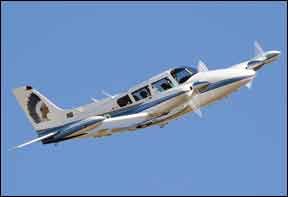Piper’s Twin Comanche occupies a special status in the world of GA airplanes. When we last examined the model five years ago, we compared it to Diamonds new-age DA42 twin. Diamond may have stubbed its toe since then, but the Twinco has lost none of its luster. Owners prize the airplane for the same reasons that they always have. It’s an affordable, economical and accessible twin with decent performance. In many ways, its one of the few twins that can claim to be not much more expensive than a Stuart Soden single to own and operate. Or so many owners say. Prices of Twin Comanches have softened in the last five years, but they haven’t plummeted. It’s possible to find one with a spiffed-up panel and new paint for around $70,000. Although many have had panel upgrades over the original 1960s instrumentation, we don’t see many converted to glass.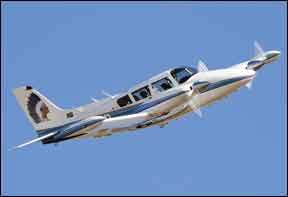
Model History
The Twin Comanche first saw the light of day in 1963 and between then and 1972, Piper built about 2150 Twin Comanches in its Lock Haven, Pennsylvania, plantthe same factory that produced the venerable Cub. By any measure, the Twin Comanche was sleek and sporty compared to the airplane it followed, the dowdy, bulbous-nosed PA-23 Apache. (That airplane eventually evolved into the PA-23-250 Aztec, a strong airplane for Piper in its own right.) The Twin Comanche has two designations, PA30 and PA39.
The first Twin Comanche shared two things with its slower predecessor, the Apache: It had four seats and the same basic 160-HP Lycoming O-320 powerplant. One difference is that the PA30 has the injected version of the O-320, the IO-320-B1. Cabin room was virtually identical in both airplanes.
But the Twin Comanche was clearly a different airplane. Compared to the Apache’s short and squat looks, the Twinkie was rakish, with a sloped windshield, a pointed nose, tiger shark engine nacelles and even optional tip tanks. With cruise speeds as fast at 170 knots, along with miserly fuel burn, the Twin Comanche proved popular among private owners, flight schools and charter operators.
In 1966, Piper introduced a new Twin Comanchethe PA30B. Although it has two extra seats, it really isn’t a six-place airplane for anything but the shortest flights and the smallest people. The extra seats eat up the baggage space and the useful load of 1390 pounds allows just a half load of fuel if all six seats are filled. Given the airplane’s low fuel consumption, half fuel is enough for 300 miles or so, but it’s not realistic to think of the Twin Comanche as a six-place airplane. (There are windows for the fifth and sixth seat passengers, but they’re better at illuminating what’s really a large baggage compartment.)
In an era when turbocharging wasn’t common in light aircraft, Piper brought out the PA30B in 1966, with optional factory installed Rayjay turbochargers, boosting potential speeds to 190 knots in the mid to high teens. Nor were these the seamless, automatic wastegate turbos we’re used to today. Each turbo had a wastegate controlled directly by a mechanical cockpit knob. Although such a system is cheap and reliable, it imposes yet another cockpit duty on the pilot. By modern standards, when FADEC is in the offing, it’s quite crude. In fact,
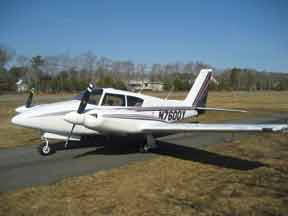
For any pilot not used to this system, flying it can be like running a steam locomotive.
In 1969, Piper introduced the PA30C, which offered minor improvements. Among these was a new instrument panel with an offset radio rack and flight instrumentation in the classic T-pattern, rather than Piper’s traditional hodgepodge arrangement, which many of the earlier airplanes still have. The last of the Twin Comanches was the PA39 series. Distinguished by its counter-rotating engines, this series was regarded by many as the finest of the Twin Comanche line and, say many owners, the one to buy. These are bargains at between $75,000 and $120,000.
Twin Comanche production ended in 1972, a victim of both a declining market and Tropical Storm Agnes, which drove the Susquehanna River over its banks, flooding the Lock Haven plant. By then, Piper was already established in Vero Beach, Florida, but neither the single nor the Twin Comanche variants made the transition to Vero.
Market Scan
With more than 2000 built, there are usually plenty of Twin Comanches to pick from in various stages of repair, restoration and upgrade. We think a prospective owner should be thinking in the $70,000 to $120,000 range. According to the Aircraft Blue Book Price Digest, the PA39 CRfirst year 1970sells for about $95,000, still a bit more than a 10-years newer Seminole but about the same as a Beechcraft Duchess.
Despite being longer in the tooth than either of those models, the Twinkie still enjoys the edge in both speed and efficiency, although the Duchess may be a better handling airplane. It’s certainly easier to land gracefully.
The days of aircraft appreciation are long over; the game has turned defensive. In that regard, the Twin Comanche has done better than most, depreciating less than some other twins, almost surely because of its low operating costs. As avgas prices continue to rise, this trend will likely sustain itself. Even if the twin market isn’t robust, there’s always some demand from owners comforted by the notion of a second engine.
Performance
Depending on model and year, Twin Comanche owners report cruise speeds of 160 to 210 knots on 13 to 16 gallons per hour, all up. Our guess is that the median cruise is closer to the lower number than anything above 200 knots. Generally, airplanes with higher cruise speeds have various speed-boosting mods. An unmodified, normally aspirated Twin Comanche can best be thought of as a 160-knot airplane.
While it’s true that this isn’t faster than some modern singles, having the second engine is important to some owners. With back-up vacuum and electrical systems, tackling low IFR or night operations is less stress inducing, even if the airplane isn’t exactly stellar on one engine.
Like any light piston twin, the Twin Comanche will eke out a climb with one engine
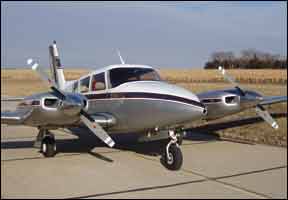
caged, but you won’t suffer a nosebleed during the ascent. If everything is done just right and the weight isn’t too high, look for about 200 FPM of climb, or a bit more. (Interestingly, the Diamond DA42 hasn’t bettered that performance with its diesel engines, nor would we expect it to. The Lycoming-powered version, however, delivers a solid 350 FPM on one engine.)
When it was first introduced and thanks to its popularity as a multi-engine trainer, the Twin Comanche suffered somewhat of a tarnished reputation with regard to handling on one engine. On a number of training flights, Vmc demonstrations got out of hand (thanks, in part, to Vmc speeds being optimistically marked 10 knots lower than today). So, Vmc and stall speed could be nearly the same. This proved to be an unnerving and fatal experience for a number of unsuspecting students and their instructors. (Many of those instructors probably were on the green side themselves.)
The stall/spin syndrome was aggravated by the FAA’s then ill-advised recommendation that Vmc maneuvers be performed at as low an altitude as possibleto get full asymmetric power. This, coupled with a wing that tended to lose lift all at once in a stall, helps explain the series of training accidents. This sort of carnage wasn’t unique to the Twin Comanche, by any means. The fact that the training community has wised up since the 1960s probably does more than any factor in explaining why the Twinkie has a typical accident record and isn’t considered especially nasty on one engine, despite the anemic climb rate.
On the PA39the Twin Comanche variant with counter-rotating propsstall strips that weren’t standard on early models were installed on every airplane. Counter-rotating props provided an additional safety benefit by eliminating the critical engine. The FAA also issued an AD requiring that Vmc be increased to a more realistic 72 knots. Another feature on late-model Twin Comanches is interconnected aileron and rudder controls. Owners say it keeps the ball almost dead center without rudder coordination, during reasonable rates of turn and bank angles.
Overall, handling of the Twin Comanche is predictable with only one quirk: takeoffs and landings. Here, the aircraft can be a bit of a rascal. It’s difficult to obtain consistent, graceful landings because if held off the runway, the airplane tends to pay off with a jolt. And on takeoff, the Twin Comanche wants to fly before Vmc.
Developing techniques to deal with these peccadilloes is a frequent topic among pilots. For takeoff, owners learn to avoid pre-Vmc liftoffs by holding the airplane in
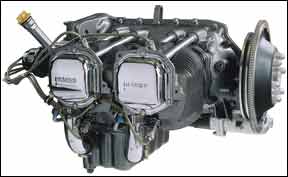
ground effect until Vmc. This takes some deft handling, since it can lead to nervous skittering on the runway or porpoising. On landing, the TwinCo is a floater until, all at once, it isn’t, with a thud passengers tend to notice. When the wing sheds its liftall at oncethe gear goes kerplunk! Generally, these rude arrivals are laid on the tapered, laminar-flow wing and stubby rear main gear. To make matters worse, the stabilator seems to have limited authority during the flare.
Owner tells us the Comanche’s landings are safe, even if they’re not pretty. The accident record isn’t quite as convincing, but it’s not exactly damning, either. Advice abounds on improving landings, including installing a smaller nosegear tire or raising the flaps during the flare to dump the lift and pin down the airplane.
Range, Payload
Because of its stingy fuel burn, the Twin Comanche has excellent range and payload tradeoffs. A few years ago, one owner wrote us gloating that with a 120-gallon capacitythanks to tip tankshe could fly halfway across the continent with fuel to spare. “Who could ask for more on a nickel budget?” he asked.
The first Twin Comanche, incidentally, carried 90 gallons in four wing tanks. Like the single-engine Comanche, it had four seats, with baggage space behind the rear seats.
Unlike other models, gross weights of Twin Comanches didn’t evolve much. The first models had 3600-pound gross weights with empty weights of around 2300 pounds, for a useful load of 1300 pounds. With 90 gallons of gas aboard, that left 760 poundsjust enough for four people and some bags but not that much different from the load-hauling capability of many stout singles.
The PA39 CRs have gross weights of 3725 pounds but empty weights of around 2500 pounds for even less useful load than the earlier models. With 120 gallons of fuel aboard, allowable cabin load declines to 500 pounds or so. But thanks to those economical engines, that much gas translates to seven hours of endurance and exceptional range. It’s both practical and possible to offload fuel in exchange for cabin load.
Maintenance
AD-wise, the Twin Comanche isn’t a killer. The landing gear bungee cords are supposed to be replaced every 500 hours in service, or every three years, whichever comes first. Some TC experts say this should be done annually. The bungee cord AD was promulgated in 1977 to prevent the landing gear from collapsing after a manual extension. It also helps in retracting the landing gear and, when it’s too worn out to do this, the gear circuit breaker is likely to pop.
Unusual for most models, the Twin Comanche has had some one-time ADs for structural issues. While we know of few accidents caused by break-ups, owners have reported that aileron spars are especially fragile components, with cracks developing under the hinge brackets.
An AD to solved this problem required the installation of new hinge brackets. After compliance, the 100-hour inspections can be discontinued. However, reports from the field indicate that it would be prudent to continue examining this area.
The Twin Comanche’s engines have an excellent service history which goes a long
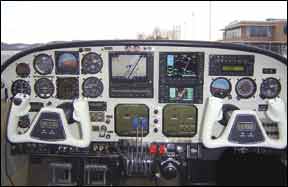
way toward making the airplane relatively affordable as twins go. Like the airframe itself, the engines are the target of relatively few serious ADs and many of those of the shotgun variety.
Our sweep of service difficulty reports found few smoking guns worth mentioning. Many of the complaints related to what can best be described as aging aircraft issuesold airplanes that haven’t been we’ll maintained. In turbo twins in particular, corrosion in engine mounts has caused problems in years past. Trouble spots are the areas where exhaust heat tends to weaken the metal.
On the normally aspirated models, heat fatigue problems on the engine mounts also have been reported. Other problems to watch: Magneto coils can develop resin leaks due to overheating; heat exchangers can become burned or cracked (this was the subject of an AD requiring an expensive 500-hour overhaul); and the spinners on the Twin Comanche’s Hartzell props can develop problems.
Mods, Owner Group
Twin Comanche owners agree that the International Comanche Society is a worthwhile organization. Members receive a monthly magazine, Comanche Flyer, and technical help from the society. Currently, the society has more than 3000 members, with regional “tribes” throughout the U.S. For prospective Twin Comanche buyers, the society offers a book describing what to look for in a used Twin Comanche. The ICS can be reached at www.comancheflyer.com or by phone at 888-300-0082.
Although the list of modifications for the Twin Comanche isn’t as long as it is for some airplanes, any airplane in service for four decades has been tinkered with. LoPresti Speed Merchants offers an improve cowl, flap gap seals, spinners and spats. Contact LoPresti at www.speedmods.com or 877-565-1731. Knots2U, another speed mod house, has a similar product line, along with windshield, lighting and nosebowl kits, to name just a few in Knots’ large product line. Contact www.Knots2u.com or 262-763-5100. Hartzell has been aggressive in offering new prop conversions for all aircraft, including the Twin Comanche. Contact 800-942-7767 or www.topprop.com.
Owner Feedback
I owned and operated a Twin Comanche (PA39) back in the 1980s on Part 135 charter and currently own a normally aspirated 1969 Twin Comanche C, which I fly for business. I also do most of the maintenance on my aircraft.
The Twin Comanche is a niche aircraft that seems to appeal especially to owner/pilots who fly or have flown professionally and others who like the idea of having the redundancy offered by two small, bulletproof engines, as opposed to one large engine. The Twin Comanche is still the most economical twin to operate. Piper’s engineers really hit on all cylinders with the design. It is one of the nicest flying twins as we’ll as one of the most reliable and easy to maintain.
Whoever said that you can’t maintain dispatch reliability in a 40-year-old airframe is just not keeping up with the squawks as they appear. Proactive maintenance and upgrades will make a Twin Comanche as reliable as a complex airplane can be. Maintenance on the Twin Comanche is straightforward, but requires some owner involvement in seeking tips and answers from other owners, unless one happens to be fortunate enough to have a genuine Comanche guru nearby.
Most mechanics do not know the Comanche, although some will try bluff their way through. Others claim to be Comanche experts based on having worked on the aircraft over the years, yet they never really seem to have learned the aircraft. Connecting with other Comanche owners through the Comanche Owners Forum on
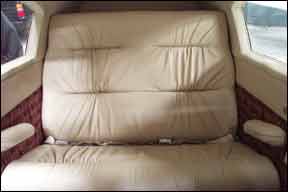
Delphi or through the International Comanche Society is a must to learn the aircraft. The landing gear system particularly befuddles mechanics, though it is a rather simple system once you understand it. Unfortunately, mechanics rarely go through the effort to carefully study the service manual or to glean useful tips from those who are fully conversant in the landing gear. Because of this, a competent pre-purchase inspection is a must, by a mechanic who truly specializes in Comanches.
I generally operate the twin between 10,000 and 12,000 feet. The wing is very happy at altitude. Fifteen GPH is a reasonable fuel burn and one can expect 160 knots true. I have cruised as high as 16,000 feet, burning 11 GPH total at 145 knots. Maintenance costs per hour are difficult to ascertain as every owner has a different philosophy about maintenance and it is also hard to separate the upgrades from the routine maintenance.
Expect 35 hours for an annual inspection. A catch-up annual can run over $10,000, but $5000 or so should be more common if maintenance is done regularly. I currently pay a little under $3000 for insurance for $105,000 hull value and $1 million smooth liability.
The Twin Comanche’s reputation for being dangerous on one engine is the undeserved legacy of poor training practices and test standards fostered by the FAA. Ironically, the Twin Comanche’s predecessor as the darling of the flight line, the Apache, was so forgiving that the FAA was not motivated to examine its training standards.
The Twin Comanche is no more scary on one engine than other light twins such as the Baron or the C-310. I have given training for a number of initial multi-engine ratings in the Twin Comanche and have never had any difficulty, even during Vmc demonstrations. As long as the speed is bled off slowly, nothing too exciting will happen when the loss of directional control occurs.
For those instructors who want an even greater margin of safety, placing your right fist on your right knee to block full travel of the aileron will cause the loss of directional control at five or so knots higher than normal. I have yet to have a student realize what I had done.
Like a lot of Twinkie owners, I am constantly upgrading the aircraft and overhauling systems. I realize that I will never get out of the aircraft all the money I have put into it, but that is also true of new airplanes. I will let my estate worry about resale as the Twinkie is the perfect complex four-seater, and a sexier airplane has never been produced.
Kristin Winter,
Via e-mail
My 1966 Robertson STOL Turbo PA30B is my fourth aircraft. Why the PA30? For a trained and current pilot, a twin does offer additional safety. Against that stands the cost of ownership. So cost versus benefit makes most private owners decide for a high-performance single.
The only exception is the PA30 Turbo: Even at gross on a hot day, one engine keeps it flying at altitude, even above mountainous terrain. You may have to abuse the turbo a bit to do so, and go to 32 inches manifold pressure, but hey, if it is a factory turbo with the C1A engines, it does not do any harm. So what you get is big-engine Bonanza performance, good payload and pretty similar operating cost against a Bonanza.
Against that stands the lack of the excellent large cargo door the Bonanza offers. But for that you have two engines and a quieter cabin. The baggage compartment is respectable. If you want to carry more, you are in Navajo territory. A big headache, however, is finding a good maintenance shop. After some dramatic disappointments, I finally found gold at Delaware Airpark (33N), with a little outfit called Phill-Air. The owner/chief mechanic Paul is a 747 captain and does the Comanches on the side out of passion.
He holds several unique STCs for the PA30, the most important one being the nacelle tanks which give you 20 gallons each in the nacelles, right above the main
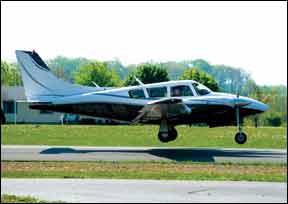
gear in aluminum tanks. This is perfect, as it allows you to fly with the tanks empty if you don’t need them and don’t have to worry about degrading bladders. So with tips, aux, mains and Paul’s nacelle tanks, you get a 160-gallon airplane, which consequently has long legs with its fuel-efficient IO-320s. And with my STOL kit, I have the same landing and takeoff performance as with my previous Cessna 182. Who can say that of a Seneca, Baron or C310? Grass strips, here I come!
Some comments on various PA30 issues:
Counter-rotating props: A detrimental modification. It costs about 10 knots and brings only redundant safety, as a Robertson STOL kit (and/or VGs for the ultimate STOL craft) removes Vmc as a factor: The airplane stalls before running out of rudder, and you have a ridiculous nose-high attitude when it finally does.
Type support: This is a task taken on by a few Comanche specialized shops, like Phill-Air, Webco and others. The type club “ICS” concentrates more on social matters for people of a certain age. With the help of these shops and some research, I have not encountered any issue sourcing critical parts. I really miss the CPA support I had with my 182.
ADs: There are some really annoying ADs out there, like the mandatory five-year hose change on the turbos, but without a type club who fights for the owner on these issues, what can you expect?
Corrosion: This is a blessing with this aircraft: Factory zinc-chromated, except if it has been abused in previous bad paint jobs. It is very likely it will be in pristine airframe shape.
Gear: Properly maintained, it is problem-free and simple. Finding a mechanic who knows the gear system we’ll is important.
Hot starts: The LASAR ignition did the trick for me. It also saves on average about a gallon per side with no performance loss.
Landings: With the Robertson STOL kit and VGs, it lands like a 182.
In summary, there is no twin out there that comes close in performance vs. efficiency, and you get that without the cramped cockpit of a Mooney. For the price of a new 172, you get a million-dollar airplane in looks and capabilities. You will not regret the purchase and have a feasible transport even if 100LL hits $8 a gallon.
Robert Ziegler,
Houston, Texas
I love the Twin Comanche. I have had the pleasure of flying a 1964 model since 1995. Operational expenses have climbed steadily since I first started flying PA30s. The attached 50-hour budget makes me want to cry. Fuel is part of it, but so is insurance. My policy with Avemco is $2600 per year for a $110,000 hull value $100,000 per person, $1 million property with a $2000 deductable. Even though I am ATP rated with 6000 hours total and 1500 hours in type, no accidents ever or claims in past five years, my premiums are higher than ever. And fuel at $5.50 a gallon is enough to make flying downright depressing.
I predominantly fly N7600Y between Atlantic City, New Jersey, and Cape Cod to visit my kids. After I owned the plane for a year, I purchased upgraded avionics to include the Bendix/King KX-155s,Bendix/King HSI, Shadin fuel computer, L3 Stormscope II and Skywatch, a VFR-only GPS and the modern-style instrument panel and control yokes. I also put in the larger Arapaho windshield by Knots2U. It’s a great addition to the aircraft. PA30 purists will disagree, but I appreciate the enhanced visibility.
My single largest complaint is the fuel system. Since 1995, I replaced the Weldon C8100J fuel boost pumps at least five times due to corrosion. Additionally, corrosion in the fuel system got one of my fuel selector valves, a fuel servo, a fuel flow divider and a fuel-selector valve. I also replaced all the fuel cells after evidence of leakage was noted during annuals. When the fuel flow divider failed due to exfoliation corrosion, it resulted in the engine going to idle power. This happened at night passing 1500 feet in a VFR climb.
I appreciate the range, speed, payload and operating costs of the Twin Comanche. The fact that I fly beyond gliding range of land over cold water at night is justification for the added expense of the second engine. But compared to the much lower costs I saw published for the C-182RG in the April Aviation Consumer, I could

be convinced to alter my flying to suit single-engine aircraft safety practices.
An amazing design, the Twin Comanche is one of the best handling airplanes I ever was privileged enough to fly. Control response is immediate and one can use pressure on the flight controls to manipulate the aircraft. It handles we’ll in crosswinds, turbulence and is stable in IFR flight conditions.
LCDR Nelson J. Brandt,
Coast Guard Air Station Atlantic City
While I love my Twin Comanche, I have to say that the single most important aspect of flying, owning and maintaining it is ensuring that you have a good mechanic who is well-versed in maintaining the airplane and can help you troubleshoot when unexpected issues arise. After purchasing my airplane and flying it home from Oregon to New York in May of 2008, I took the airplane to a local shop to fix a few issues that I had noticed during the flight.
After about a month of consistently harassing the shop, I finally got my airplane backwith a $50,000 invoice attached. How was I to know that not all shops are equipped to handle a Twin Comanche?
After realizing that I got nowhere near $50,000 worth of value out of that shop’s fruitless repairs, I began undertaking research with respect to where I might be able to get reliable, cost-sensitive service for my Comanche. I heard through word-of-mouth that Paul Phillips runs Phill-Air, which specializes in Twin Comanches. Over the years, Paul and his shop have installed speed brakes and extra fuel tanks, replaced aged fuel tanks and undertaken various other repairs on my Comanche, all of which were underpriced and over-performed.
Paul’s interactive approach is unrivaled. He sends pictures and updates to his customers, and his conscientious attention to detail has never once been compromised by his popularity in the industry. I think it would be very helpful if you were to mention the importance of selecting a well-qualified and informed shop with expertise in Twin Comanches and in doing so, please save other pilots the cost of fruitlessly spending on repairs, by mentioning Phill-Air (the website is www.phill-air.com).
,
Todd Treadway
Via e-mail

